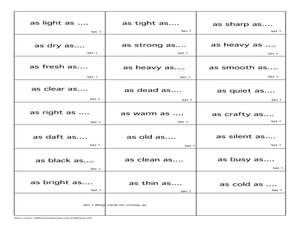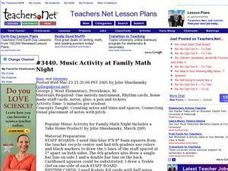Houghton Mifflin Harcourt
Let’s Count!: Extra Support Lessons (Theme 5)
In a themed series of lessons and activities, beginner readers are given extra support in reading through chants, games, and practice worksheets.
Willow Tree
Simple Probability
The probability of learning from this lesson is high! Learners calculate probabilities as numbers and as decimals. They see how to use a complement to find a probability and even try a simple geometric probability problem.
National Security Agency
Time After Time
Save those precious minutes and hours spent planning math lessons with this mini-unit on telling time. Offering a series of engaging hands-on and collaborative learning activities, these three lessons teach children how to read analog...
Oregon Department of Education
Building Number Sense
It's never too early to begin a child's math education. This collection of fun hands-on activities engage youngsters in building their number sense as they learn how to count objects, identify numerals, compare amounts, and much more.
ESL Kid Stuff
Seasons
English language learners celebrate the seasons with games, songs, and readings.
Mathematics Vision Project
Similarity and Right Triangle Trigonometry
Starting with similar triangles and dilation factors, this unit quickly and thoroughly progresses into the world of right triangle features and trigonometric relationships. Presented in easy-to-attack modules with copious application...
Federal Reserve Bank
Your Credit Report
What is your credit score? How do you find it? Help your pupils answer these questions and more. They will access their free credit report and then analyze its meaning.
EngageNY
Mid-Module Assessment Task - Geometry (Module 1)
How do you prepare class members for the analytical thinking they will need in the real world? An assessment requires the higher order thinking they need to be successful. The module focuses on the concept of rigid transformations...
EngageNY
Applications of the Pythagorean Theorem
Begin seeing the world through the lens of geometry! Use the 19th installment in a 25-part module to apply the Pythagorean Theorem to solve real-world problems. Individuals sketch situations resulting in right triangles such as the...
Lesson Plans
Analogy of the Cell Project
Intended to supplement your existing cell function and organelle lessons, pairs work together to develop a real-world analogy for cell structures. In addition to writing paragraphs about the comparison, each group will make a short...
Colorado Unit Writing Project
Fun with Phonemic Awareness
The phonemic awareness activities in this packet are designed to help kids develop skills in rhyming, syllabication, blending onsets and rimes, and beginning and ending sounds. Well worth a place in your curriculum library.
ReadWriteThink
Beyond the Story: A Dickens of a Party
It's time to party like it's 1899! Incorporate a research-based celebration of the Victorian Era into your unit on A Christmas Carol by Charles Dickens. After learners read the novella or view a production of the play, they craft a...
PBS
Robo Arm
Future engineers create robotic arms like those on rovers built by NASA in the second lesson of the series. They test their devices by attempting to pick up and move cups to a specified location.
Science Matters
Ring of Fire
Over a period of 35 years, earthquakes and volcanoes combined only accounted for 1.5 percent of the deaths from natural disasters in the United States. The 15th lesson in a 20-part series connects the locations of earthquakes and...
Missouri Department of Elementary
“Re-Solutioning”: Practice Brings Out Our Best
Seventh graders create and perform a skit that demonstrates their conflict resolution skills. They begin by examining the process of crafting a performance and review what they have learned about conflict resolution. Next, they...
Curated OER
Simile Bingo
In this simile bingo worksheet, students play bingo with words and pictures on it and fill in the blanks to similes with those words. Students play with 4 players.
Curated OER
Places in My Community
Students determine the different businesses and buildings in their community. In this community activity, students identify different community locations and their purpose in the community. Afterward, the students collectively sing a...
Curated OER
Animal Vocabulary Cards
Students practice a system that may help them understand more and remember more terms when they read. The reading of text is developed as a skill that second language learners need.
Curated OER
Presidents
Fifth graders use almanacs to take notes on their individual presidents on a note card. They fill in a variety of biographical information on their president. They convert their information into whole paragraphs.
Curated OER
No Plagiarism, Please!
Third graders listen to a lecture on how to take notes and discuss the skills of paraphrasing and correctly citing resources. They prepare note cards according to the format presented in class.
Curated OER
Research and Technical Writing
Students summarize information from their research on to note-cards. In this technical writing lesson students examine examples of note-cards that contain main ideas from research previously conducted. They will then compose their own...
Curated OER
Music Activity at Family Math Night
Students work with a family member in placing all of the music notes on a staff board. They try to match the rhythm on the rhythm board and show their completed song to the teacher.
Curated OER
Travel to the Timeline
Second graders create timelines of historic events, They place note cards listing events in proper order on paper plates laid out on the gym floor. They trade note cards with other groups and continue the game.
Curated OER
Animal Report - Outlines
Fourth graders are introduced to the outline format and how to organize information from notes into a finished outline. They use a form to compile researched information into an outline in preparation for writing a final report.

























